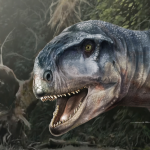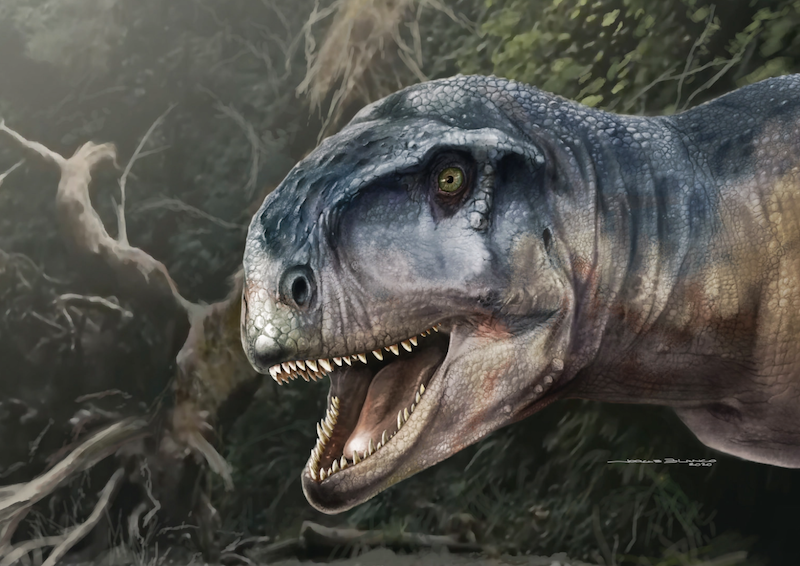

Image via Jorge Blanco/ Taylor & Francis Group.
Paleontologists in Argentina have described a newly discovered species of dinosaur – named Llukalkan aliocranianus, or ‘one who causes fear’ – in a study published March 31, 2021, in the peer-reviewed Journal of Vertebrate Paleontology.
Around 80 million years ago, as tyrannosaurs ruled the Northern Hemisphere, this lookalike carnivore flourished in the southern continents. The fearsome predator could be as long as an elephant, had extremely powerful bites, very sharp teeth, and huge claws in their feet, the scientists reported.
Researchers unearthed the fossil remains – including an extremely well-preserved and intact braincase – in the Bajo de la Carpa Formation in Argentina, in 2015. Llukalkan means “one who causes fear” in the language of the indigenous Mapuche people, and aliocranianus is Latin for “different skull.”
Llukalkan was likely among the top predators throughout what’s now Argentina during the Late Cretaceous, (100.5–66 million years ago) said the researchers, due to its formidable size (up to 16 feet – or 5 five meters – long), extremely powerful bite, and keen sense of smell. Llukalkan was fast, thanks to its powerful hind legs, and might have used its huge claws to stab or tear down their prey while moving.
Llukalkan was part of a family of dinosaurs called abelisaurids. Abelisaurids were a striking family of theropods – a group of carnivorous dinosaurs that typically walked on two legs – that prowled mainly in what’s now southern South America, and other areas of what’s now Africa, India, Antarctica, Australia. While abelisaurids generally resembled T-Rex, with tiny stubby arms, they had unusually short, deep skulls which often bore crests, bumps, and horns.
According to the researchers’ analysis of the fossil braincase, Llukalkan had a strange short skull with rough bones, so its head probably had bulges and prominences like some current reptiles such as the Gila monster or some iguanas.
Also, the make-up of Llukalkan’s skull suggests that its hearing was different from that of most other abelisaurids – probably better – and similar to that of modern-day crocodiles. Paleontologist Federico Gianechini, of the National University of San Luis, Argentina, is the study lead author. He told CNN:
A peculiarity of this dinosaur is that it has cavities in the ear area that other abelisaurids did not have, which could have given this species different auditory capacities, possibly a greater hearing range. This, together with its keen sense of smell, would have given great capabilities as a predator to this species.
Study co-author Ariel Mendez from the Patagonian Institute of Geology and Palaeontology in Argentina said that the fossil evidence of Llukalkan’s adaptations suggests that abelisaurids were flourishing right before the dinosaurs went extinct.
These dinosaurs were still trying out new evolutionary pathways and rapidly diversifying right before they died out completely.
Bottom line: Around 80 million years ago, as tyrannosaurs ruled the Northern Hemisphere, this newly discovered lookalike – named Llukalkan aliocranianus, or the ‘one who causes fear’- flourished in the southern continents.
from EarthSky https://ift.tt/31Su5I6


Image via Jorge Blanco/ Taylor & Francis Group.
Paleontologists in Argentina have described a newly discovered species of dinosaur – named Llukalkan aliocranianus, or ‘one who causes fear’ – in a study published March 31, 2021, in the peer-reviewed Journal of Vertebrate Paleontology.
Around 80 million years ago, as tyrannosaurs ruled the Northern Hemisphere, this lookalike carnivore flourished in the southern continents. The fearsome predator could be as long as an elephant, had extremely powerful bites, very sharp teeth, and huge claws in their feet, the scientists reported.
Researchers unearthed the fossil remains – including an extremely well-preserved and intact braincase – in the Bajo de la Carpa Formation in Argentina, in 2015. Llukalkan means “one who causes fear” in the language of the indigenous Mapuche people, and aliocranianus is Latin for “different skull.”
Llukalkan was likely among the top predators throughout what’s now Argentina during the Late Cretaceous, (100.5–66 million years ago) said the researchers, due to its formidable size (up to 16 feet – or 5 five meters – long), extremely powerful bite, and keen sense of smell. Llukalkan was fast, thanks to its powerful hind legs, and might have used its huge claws to stab or tear down their prey while moving.
Llukalkan was part of a family of dinosaurs called abelisaurids. Abelisaurids were a striking family of theropods – a group of carnivorous dinosaurs that typically walked on two legs – that prowled mainly in what’s now southern South America, and other areas of what’s now Africa, India, Antarctica, Australia. While abelisaurids generally resembled T-Rex, with tiny stubby arms, they had unusually short, deep skulls which often bore crests, bumps, and horns.
According to the researchers’ analysis of the fossil braincase, Llukalkan had a strange short skull with rough bones, so its head probably had bulges and prominences like some current reptiles such as the Gila monster or some iguanas.
Also, the make-up of Llukalkan’s skull suggests that its hearing was different from that of most other abelisaurids – probably better – and similar to that of modern-day crocodiles. Paleontologist Federico Gianechini, of the National University of San Luis, Argentina, is the study lead author. He told CNN:
A peculiarity of this dinosaur is that it has cavities in the ear area that other abelisaurids did not have, which could have given this species different auditory capacities, possibly a greater hearing range. This, together with its keen sense of smell, would have given great capabilities as a predator to this species.
Study co-author Ariel Mendez from the Patagonian Institute of Geology and Palaeontology in Argentina said that the fossil evidence of Llukalkan’s adaptations suggests that abelisaurids were flourishing right before the dinosaurs went extinct.
These dinosaurs were still trying out new evolutionary pathways and rapidly diversifying right before they died out completely.
Bottom line: Around 80 million years ago, as tyrannosaurs ruled the Northern Hemisphere, this newly discovered lookalike – named Llukalkan aliocranianus, or the ‘one who causes fear’- flourished in the southern continents.
from EarthSky https://ift.tt/31Su5I6

Aucun commentaire:
Enregistrer un commentaire